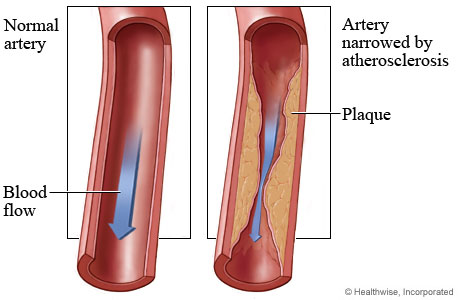Coronary Artery Disease
Overview
The heart is a muscle, and like any muscle, it needs blood to work well. Coronary artery disease occurs when the arteries that bring oxygen-rich blood to your heart have a buildup of plaque—deposits of fats and other substances. Plaque can reduce blood flow to the heart muscle. This can cause angina symptoms such as chest pain or pressure. A heart attack can happen if blood flow is completely blocked.
You can do a lot to improve your health and prevent a heart attack. Eating healthy food, not smoking, getting regular exercise, and taking your medicine are the main things you can do every day to stay healthy.
Symptoms
Coronary artery disease

Coronary artery disease happens when fatty deposits called plaque (say "plak") build up inside your coronary arteries. This process of plaque buildup is called atherosclerosis.
Coronary arteries are the blood vessels that supply blood and oxygen to your heart muscle. Plaque buildup may reduce the amount of blood that gets to your heart. Coronary artery disease can cause angina symptoms, such as chest pain or pressure. It can lead to a heart attack. Treatment for coronary artery disease can help relieve symptoms and lower your risk of a heart attack.
What are the symptoms of coronary artery disease?
The symptoms of coronary artery disease are angina (say "ANN-juh-nuh" or "ann-JY-nuh") and shortness of breath. Symptoms can happen when the heart is working hard and does not get enough oxygen, such as during exercise. Some people don't have any symptoms.
People feel angina symptoms in different ways. Symptoms include chest pain or pressure, or a strange feeling in the chest. Some people feel pain, pressure, or a strange feeling in the back, neck, jaw, or upper belly, or in one or both shoulders or arms. Other symptoms of angina include nausea or vomiting, lightheadedness or sudden weakness, and a fast or irregular heartbeat.
Angina can be stable or unstable. Stable angina means that you can usually predict when your symptoms will happen. Unstable angina means that your symptoms have changed from your typical pattern of stable angina. It may be a heart attack.
Causes
What causes coronary artery disease?
Coronary artery disease is caused by a process called hardening of the arteries, or atherosclerosis.
Atherosclerosis occurs when fatty deposits called plaque build up inside arteries. Arteries are the blood vessels that carry oxygen-rich blood throughout your body. When plaque builds up in the arteries that supply blood to the heart muscle (the coronary arteries), it is called coronary artery disease. Over time, the plaque may narrow the arteries and reduce blood flow to the heart muscle.
Prevention
How can you prevent coronary artery disease?
- Do not smoke. It may be the best thing you can do to prevent coronary artery disease. If you need help quitting, talk to your doctor about stop-smoking programs and medicines. These can increase your chances of quitting for good.
- Be active. Try to do moderate activity at least 2½ hours a week. Or try to do vigorous activity at least 1¼ hours a week. You may want to walk or try other activities, such as running, swimming, cycling, or playing tennis or team sports.
- Eat heart-healthy foods. Eat more fruits and vegetables and less food that contains saturated and trans fats. Limit alcohol, sodium, and sweets.
- Stay at a healthy weight. Lose weight if you need to.
- Manage other health problems such as diabetes, high blood pressure, and high cholesterol.
Diagnosis
How is coronary artery disease diagnosed?
Your doctor will do a physical exam and ask questions about your symptoms, personal health history, and family medical history.
During the physical exam, your doctor will check many things. These include checking your blood pressure and listening to your heart and lungs.
You will likely have tests to check how well your heart is working and check blood flow to your heart muscle. Examples of tests include an electrocardiogram, an echocardiogram, stress tests, a cardiac perfusion scan, and a CT angiogram.
Support
How can support help you manage coronary artery disease?
Heart disease can bring a lot of changes in how you manage your health. But with friends, family, and your care team helping you along the way, making these changes can feel more possible.
Support from others can be little things that mean a lot. Or it can be a big thing that makes a huge difference.
Support helps you feel:
- Strong enough to make heart-healthy changes.
- Confident, especially when you feel unsure.
- Connected to other people.
Can you think of what else support could do for you?
Chances are that you are taking care of yourself quite well. But maybe a little support could make it easier.
So reach out to others, and ask for help. A support system can give you a boost when you need it most.
Treatment
Coronary artery disease: Making an activity plan
Being active is good for you and your heart. Even when you have a heart problem, activity helps your heart get stronger.
You might find it hard to think about getting active. You may be worried about your heart. Or maybe you're not sure how to get started. This happens to a lot of people. A plan can help you know what to do, for how long, and how hard.
Here's how to get started.
- Prepare to make a plan with your doctor.
To help prepare for your visit, you might want to go in with an idea of something that you enjoy doing. Start small. It could be a short walk with a coworker during a work break. Remember that you're not training for a marathon. Your goal is to help yourself feel better and your heart get stronger.
- Decide on an exercise.
Together you and your doctor can decide:
- What type of exercise should you do? What do you enjoy doing? If you can't think of anything right now, walking is a great way to start moving.
- How often should you exercise? And for how long? You and your doctor can set goals. You don't need to do it all at one time. You can spread your activity throughout your day. It's fine to be active in short periods of time throughout your day and week. Those little activities can add up.
- How hard should you exercise? When you exercise, pay attention to how you feel. You don't have to push yourself. If you can't talk while you exercise, then you're doing too much.
Your doctor may want to do an electrocardiogram (EKG or ECG), and maybe an exercise stress test to see how much activity your heart can safely handle.
- Build your plan.
Your doctor may offer other ideas of ways for you to move. You can choose from these, or you can come up with your own. Only you know what will work best for you.
In your plan:
- Write down activities you enjoy doing. For example: "Walking with my neighbor."
- Note if these activities were okayed by your doctor.
- Write down how often, how long, and how hard to do these activities. For example: "Walk 30 minutes a day. I can break this up into 3 10-minute walks."
- Add any notes that can help you meet your goals. For example: "To know how hard I am working out: I can talk, but not sing."
- Remember that activity helps more than your heart.
While you make your plan, remember that your whole body and mind get healthier with even a little activity. For example, activity can help you feel better, reduce stress, and have more energy.
When to Call
How is coronary artery disease diagnosed?
Your doctor will do a physical exam and ask questions about your symptoms, personal health history, and family medical history.
During the physical exam, your doctor will check many things. These include checking your blood pressure and listening to your heart and lungs.
You will likely have tests to check how well your heart is working and check blood flow to your heart muscle. Examples of tests include an electrocardiogram, an echocardiogram, stress tests, a cardiac perfusion scan, and a CT angiogram.
Self-Care
How can you care for yourself when you have coronary artery disease?
There are many things you can do to feel better, prevent problems, and stay healthy longer.
You can lower your risk for heart attack and stroke by making lifestyle changes and taking medicine. A heart-healthy lifestyle can also improve the quality and length of your life.
- Take medicine properly.
- Take your medicine exactly as directed. You may take several medicines.
- Have a heart-healthy lifestyle.
- Eat healthy foods, be active, stay at a healthy weight, and don't smoke.
- Manage angina symptoms.
- If you have angina, pay attention to your symptoms and know when to call a doctor or get emergency help.
- Manage and prevent other health problems.
- Manage diabetes, high blood pressure, and high cholesterol. Get vaccinated against COVID-19, the flu, and pneumonia. Get help for depression. Get help if you think you may have a problem with alcohol or drug use.
- Take other steps to stay healthy.
- For example, manage stress and limit alcohol.
Copyrighted material adapted with permission from Healthwise, Incorporated. This information does not replace the advice of a doctor.



